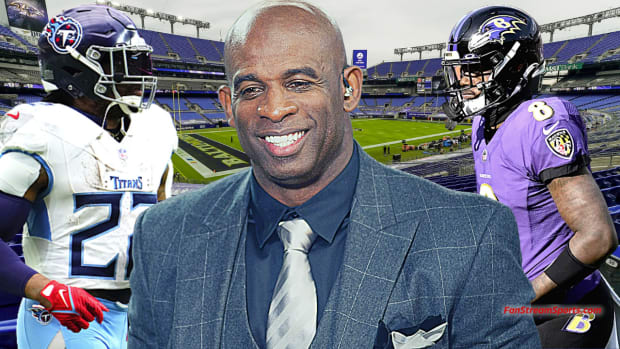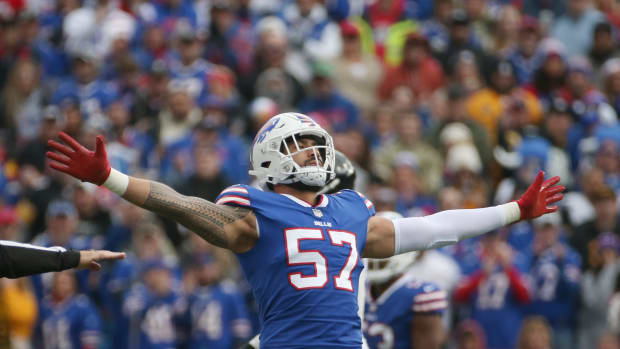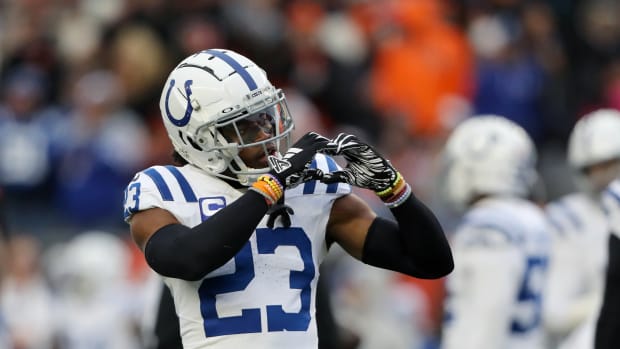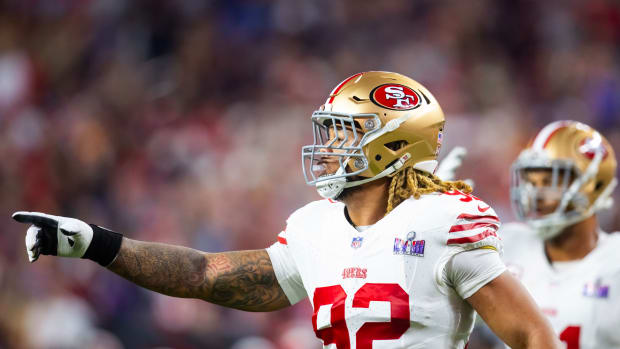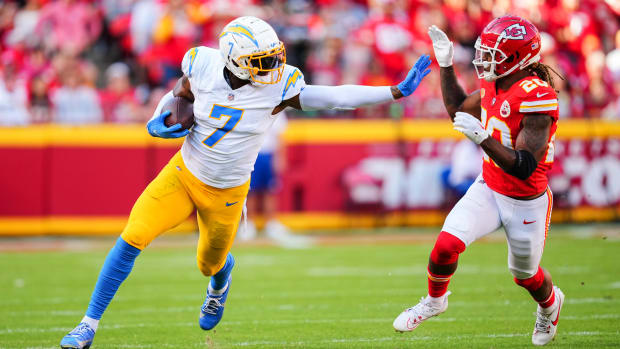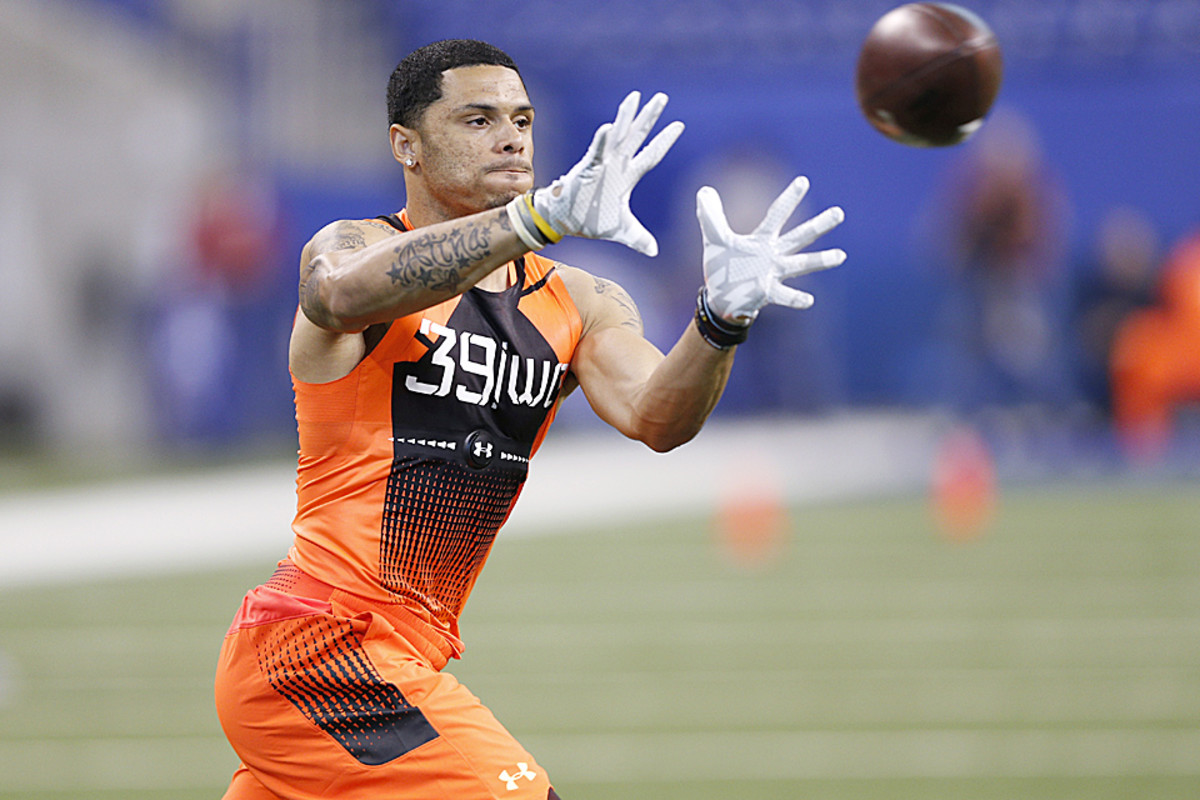
T-Minus 63 Days: The Combine's Myth Busters
INDIANAPOLIS — I’ve spent the last two weeks downplaying the import of the scouting combine—at least the version we see on television. So as we put the combine to bed and look forward to various pro days, here’s one thing the Underwear Olympics is great for: dispelling myths about prospects.
More than 330 players participated last week in Indianapolis, and each of them came in with something to prove. Ohio State wide receiver Devin Smith knew he would run a good 40, and everyone expected the former NCAA sprinter and high jumper to post excellent measurables. But what no one expected, and what Smith was pining for, was positive reviews for his route-running.
Primarily a deep ball threat at Ohio State, with big-armed Cardale Jones finding him downfield consistently late in the season, Smith disappeared in some games (during one three-game stretch last season he caught four passes total). The conventional wisdom in the scouting community was that Smith was a one-trick pony with questionable intermediate route-running. Thus, Smith spent the better part of his combine prep fine-tuning his cuts at EXOS in San Diego. Rather than take a break after winning a national championship and participating in the Senior Bowl, he bypassed a chance to spend some time at home in Akron and began training immediately.
Smith averaged four more yards per catch (28.2) than anyone else in the nation last season. (Jamie Sabau/Getty Images)
“I wanted to work on the slants, the ins, the outs, curls,” Smith says. “Everybody knows I can go deep. I’ve displayed that throughout my whole career. It kind of frustrates me when people say that’s all I can do because I know I can run all the other routes. I ran them all in high school and college.”
And he ran them all in Indianapolis, to positive reviews. He caught almost everything, too. Said one NFC scout: “He looks like your classic guy who was hamstrung in a system and got pegged, when in reality he can do a lot.”
Sixteen teams interviewed Smith, projected as a second-round pick. Educated guess: The Raiders, Rams, Chiefs and Ravens will be in the Smith market come April.
Said Smith: “I just feel like, with the offense we were in, we’re just gonna run the go because we’re so good at it. We’ve got a big-armed quarterback so we used that to our advantage and did it a little more than other teams.”
MMQB Roundtable
Peter King, Robert Klemko and Jenny Vrentas discuss the top takeaways coming out of the combine and look ahead to free agency, including the fate of Ndamukong Suh. FULL STORY
A lot more. More than half of Smith’s catches in 2014 went for 25 yards or more. In addition, Smith lined up as a gunner on the punt team, and didn’t realize it was a big deal to have the best receiver playing special teams until Urban Meyer pulled him aside after the Wisconsin game junior year and congratulated him on a punt team stop inside the opponent’s 10-yard line.
“He called it solving the mystery,” Smith says. “He saw not just my play grow but everybody’s play grow.”
Smith was uniquely capable for all that running. He starred on the Buckeyes’ track team up until his junior year, never taking more than three days off between seasons. After the Orange Bowl in early 2014, Smith would wake up for 6 a.m. football workouts, then class, then track workouts in the early evening. The last time he took a week off of running?
“Probably sixth grade.”
Such was his reputation for speed that his 4.42 40-yard dash disappointed some, including one AFC scout I spoke with: “He ran just O.K. for a legitimate deep threat. He was expected to be much faster.”
It’s the combine. Everyone’s a critic.
Five Things You Need To Know About The Draft
Five well-known players from big schools who stepped up in Indianapolis and dispelled some of the biggest concerns surrounding their games.
1. Stephone Anthony, ILB, Clemson
Knock: One-dimensional
Anthony ran a 4.56 40-yard dash and a 4.03 20-yard shuttle, demonstrating an ability to cover ground no one expected. “In theory,” said one AFC scout, “that changes his scouting report from a two-down guy to a possible three-down linebacker.”
Bedard's Draft Breakdowns
Greg Bedard broke down some of the draft's top prospects over the past season. Marcus Mariota: Everything but the fireJameis Winston: Is he worth the trouble?Melvin Gordon: Can he break the RB first-round drought?
2. Marcus Mariota, QB, Oregon
Knock: Not “pro ready”
The second QB on most draft boards gets downgraded for thriving in an offense with simplified reads. We keep hearing he’s not “pro ready” like Jameis Winston, who spent far more time under center (we’ll get into the fallacy of the “pro ready” tag later.) Here’s what one scout told me about the chalk talks Mariota had with several teams: “He did much better on the board than expected and his football IQ was surprisingly good.”
3. Landon Collins, S, Alabama
Knock: Too slow
Collins posted average agility numbers but stunned some scouts with a 4.53 40 time, fifth best among this class of safeties. Celebrated as a run stopper and criticized in coverage, Collins made a few teams take a second look at the tape with his straight-line speed.
4. Angelo Blackson, DT, Auburn
Knock: One-dimensional
Blackson challenged the notion that he’s little more than a gap plugger by weighing in at 318 lbs. and still posting impressive 10-yard shuttle and 20-yard dash times. Said one NFC scout: “He may have opened the door for a lot of these teams who were thinking he was just a run stuffer.”
5. Vic Beasley, OLB, Clemson
Knock: Undersized
Going into this combine, you had to wonder if Beasley was physically capable of setting the edge in the run game. He was listed at 230 lbs. with relatively short arms and a narrow frame. Beasley answered those concerns by showing up in Indianapolis at 246 and dominating every measurable drill he participated in.
Photo by Tom Szczerbowski/Getty Images
Draft Season Do-Over
Every week, we’ll ask a current NFL player what he would have done differently in the time between his final collegiate game and the day he was drafted…
Cleveland Browns S Johnson Bademosi (2012, undrafted). “I put so much focus and effort and energy into figuring out where I was going to train and worrying about how I wasn't invited to the combine, and it was for nothing. All of these other guys were working out at the big facilities and people said the agents had deals worked out with the facilities and you could only get in if you had one of those agents. I ended up training at school and it was the best thing for me because I was able to finish school and get my degree. Then I got an opportunity as an undrafted free agent and made the most of it. All the worry and stress was unnecessary.”
Better Know a Prospect
Photo by Chris Covatta/Getty Images
Normally we reserve the Better Know a Prospect portion of the column for guys likely to be picked in the later rounds, but seeing as this guy’s combine performance made headlines, and I can't exactly peg him to a round, Paul Dawson might be the exception. I've heard everything from first round to seventh on this guy, all from sources I know and trust (which goes to show how varied and inexact the scouting formula remains). I think the truth is somewhere closer to Round 1.
Some called Dawson the best linebacker in the class prior to the combine. Then the TCU product arrived in Indianapolis. He weighed in light for a linebacker at 230 and ran a 4.93-second 40 with a 28-inch vertical leap and 9-foot, 1-inch broad jump. For comparison, a year ago 302-pound Nevada guard Joel Bitonio broad-jumped nine-and-a-half feet and he recorded a 32-inch vertical. Add to that Dawson’s admission that he was tardy "a lot" to meetings at TCU (something coaches were happy to leak to scouts), and Dawson begins to look like draft season’s biggest free-faller.
So what will save him? I had the pleasure of meeting Dawson to go over his film. We watched TCU’s destruction of Ole Miss in the Peach Bowl, and I really came to understand what he was all about. He operates on a cocktail of intense film study and a quick trigger. He can get engaged by nimble offensive linemen, but more often he’s sidestepping them and knifing towards ball carriers. On one first-quarter play, he sniffs out a misdirection run based on the solitary observation of a wing back aligned too far to the inside. He memorizes the attributes of the opposing tight ends and receivers to understand what the opponent might do in various personnel sets.
Stories Behind the Prospects
Lynden Trail: The draft's biggest mystery man comes from little Norfolk State.T.J. Clemmings: A switch from defense to offensive tackle awakened a monster.Shaq Thompson: Before he was an NFL prospect, he was baseball's worst player.
“I would be late to meetings, and that’s my fault,” he says, “but I would be the last guy in the building watching tape on the other team.”
How many Ole Miss games did he watch prior to the Peach Bowl?
“All of them.”
In the fourth quarter, there’s a play that still irks Dawson. Ole Miss is threatening at the TCU 9-yard line on third down. The running back motions left in a ploy to freeze the linebackers, but Dawson ignores him, anticipates a wide receiver screen and probably would’ve picked it off for a 91 yard return if he hadn’t been—get this—too early.
“They do a lot of screens in goal line, when they need like five yards for a touchdown,” he says. “It’s the same play Laquon Treadwell broke his leg on earlier in the season. I was telling everybody I would pick off that play, and I just got too excited.”
Imprudence on the field was one reason the converted high school wide receiver didn’t start until the sixth game of his junior season. He would occasionally forget assignments and just sprint to the ball. Before his first start, against Kansas in 2013, he dove into the film study and saw results: 17 tackles against Kansas on his way to 91 stops as a junior. A year later he collected 136 tackles, 20 TFL, six sacks and four interceptions. With the All-America nod, the press was overwhelmingly positive until the TCU staff started talking.
“I’ll just google myself when I’m bored and see what people are talking about,” Dawson says. “I told myself I had to stop reading all that.”
If he reads one last thing on the internet, let it be this: The team that drafts Dawson will get a football player, if not a track star.
Quote of the Week
“I don't care if a guy at the Combine talks passion. I care more if I see it on tape by him going full blast 100 percent on every snap. The Combine is all about measurables. It is an important part that helps you make decisions—but only after watching the tape. And even then, you still don't know how it is all going to turn out. What we are all doing is making a very good, calculated, educated, theory-based guess.”
—Carolina Panthers running backs coach Jim Skipper, entering his 33rd season as a professional football coach, to SB Nation’s Thomas George.
Stat of the Week
For this week we might as well rename the section Stat Guy of the Week. That title goes Marcus Armstrong, a software engineer and Jets fan living in Boston who brings us a unique way of looking at prospects via his no-frills site, mockdraftable.com.
Draft Projections
NFL film breakdown maven Andy Benoit and college football expert Andy Staples combine their knowledge to peg which prospects fit best with which teams. AFC East: A QB to Gang Green? A new Wilfork in New England?AFC North: A new target for Flacco? A pass-rusher joins the Steel Curtain?
Armstrong compiled combine data going back to 1999 and created digital representations of the percentile each player achieved in each combine event relative to his draft class position. The data is represented in the form of a polygon, inspired by a
Madden
franchise mode feature some years back. A big data “spread” indicates a top performer.
“Back in the day, for franchise mode, you’d get to see the draft prospects laid out on a 5-dimensional spider chart,” Armstrong tells me. “I always thought that was a great way of visualizing the space, so when I ended up with this whole database of measurables, I pretty quickly reached for it as a great way to get context for the relatively opaque numbers that the combine gives you.”
The results can be deceiving. Calvin Johnson and DeMarcus Ware earned huge spreads, but so did Logan Thomas and Taylor Mays. For added kicks, Armstrong fixed it so you could compare each player to other positions. For instance, you can see how AJ McCarron would’ve compared to the 2014 defensive ends (uh, not well).
For a more practical application, look no further than the immaculate spread of Clemson DE Vic Beasley, who, at 246 pounds, would have ranked in the top half of cornerbacks in the three-cone and 20-yard shuttle agility tests.
If you’re like me, this sort of thing never gets old.
Scorching Hot Take of the Week
The runner-up...
And this week’s winner...
And in a very special edition, the first-ever sober take of the week...
Jason Lisk of the Big Lead laid waste to a recent draft axiom, “pro-ready,” used most often to describe quarterbacks. I’m guilty of using it and having only a vague sense of what it means. Lisk provided a list of guys described as pro ready in recent years, and it includes the likes of Brandon Weeden, Ryan Lindley, Matt Barkley, Ryan Nassib, Zach Mettenberger and David Fales.
Lisk: “When players have been described as ‘pro-ready’ or not ‘pro-ready,’ it seems to have little predictive value in determining whether they are ready to play professional football at a high level, immediately or in the future.”
Follow The MMQB on Facebook, Twitter and Instagram.
[widget widget_name="SI Newsletter Widget”]










































